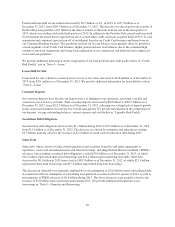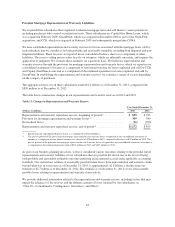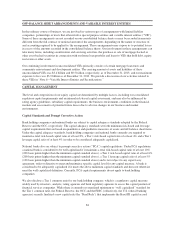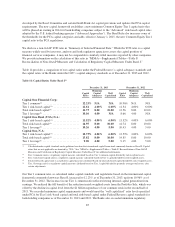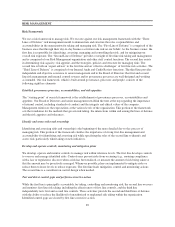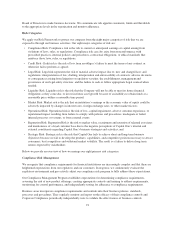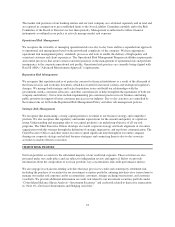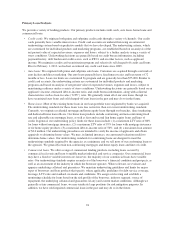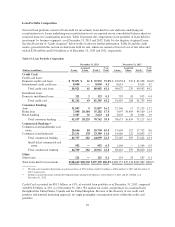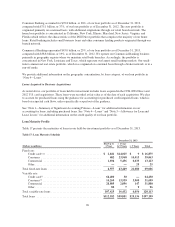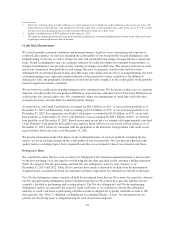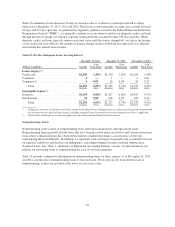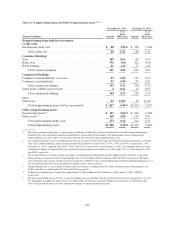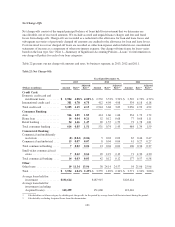Capital One 2013 Annual Report Download - page 111
Download and view the complete annual report
Please find page 111 of the 2013 Capital One annual report below. You can navigate through the pages in the report by either clicking on the pages listed below, or by using the keyword search tool below to find specific information within the annual report.Board of Directors to make business decisions. We communicate risk appetite statements, limits and thresholds
to the appropriate levels in the organization and monitor adherence.
Risk Categories
We apply our Risk Framework to protect our company from the eight major categories of risk that we are
exposed to through our business activities. Our eight major categories of risk are:
• Compliance Risk: Compliance risk is the risk to current or anticipated earnings or capital arising from
violations of laws, rules, or regulations. Compliance risk can also arise from nonconformance with
prescribed practices, internal policies and procedures, contractual obligations, or ethical standards that
reinforce those laws, rules, or regulations;
• Credit Risk: Credit risk is the risk of loss from an obligor’s failure to meet the terms of any contract or
otherwise fail to perform as agreed;
• Legal Risk: Legal risk represents the risk of material adverse impact due to: new and changed laws and
regulations; interpretations of law; drafting, interpretation and enforceability of contracts; adverse decisions
or consequences arising from litigation or regulatory scrutiny; the establishment, management and
governance of our legal entity structure; and the failure to seek or follow appropriate Legal counsel when
needed;
• Liquidity Risk: Liquidity risk is the risk that the Company will not be able to meet its future financial
obligations as they come due, or invest in future asset growth because of an inability to obtain funds at a
reasonable price within a reasonable time period;
• Market Risk: Market risk is the risk that an institution’s earnings or the economic value of equity could be
adversely impacted by changes in interest rates, foreign exchange rates, or other market factors;
• Operational Risk: Operational risk is the risk of loss, capital impairment, adverse customer experience, or
reputational impact resulting from failure to comply with policies and procedures, inadequate or failed
internal processes or systems, or from external events;
• Reputation Risk: Reputation Risk is the risk to market value, recruitment and retention of talented associates
and maintenance of a loyal customer base due to the negative perceptions of Capital One’s internal and
external constituents regarding Capital One’s business strategies and activities; and
• Strategic Risk: Strategic risk is the risk that Capital One fails to achieve short and long-term business
objectives because we fail to develop the products, capabilities, and competitive position necessary to attract
consumers, beat competitors and withstand market volatility. The result is a failure to deliver long term
returns expected by stakeholders.
Below we provide an overview of how we manage our eight primary risk categories.
Compliance Risk Management
We recognize that compliance requirements for financial institutions are increasingly complex and that there are
heightened expectations from our regulators and our customers. In response, we continuously evaluate the
regulatory environment and pro-actively adjust our compliance risk program to fully address these expectations.
Our Compliance Management Program establishes expectations for determining compliance requirements,
assessing the risk of new product offerings, creating appropriate controls and training to address requirements,
monitoring for control performance, and independently testing for adherence to compliance requirements.
Business areas incorporate compliance requirements and controls into their business policies, standards,
processes and procedures. They regularly monitor and report on the efficacy of their compliance controls and
Corporate Compliance periodically independently tests to validate the effectiveness of business controls.
91



